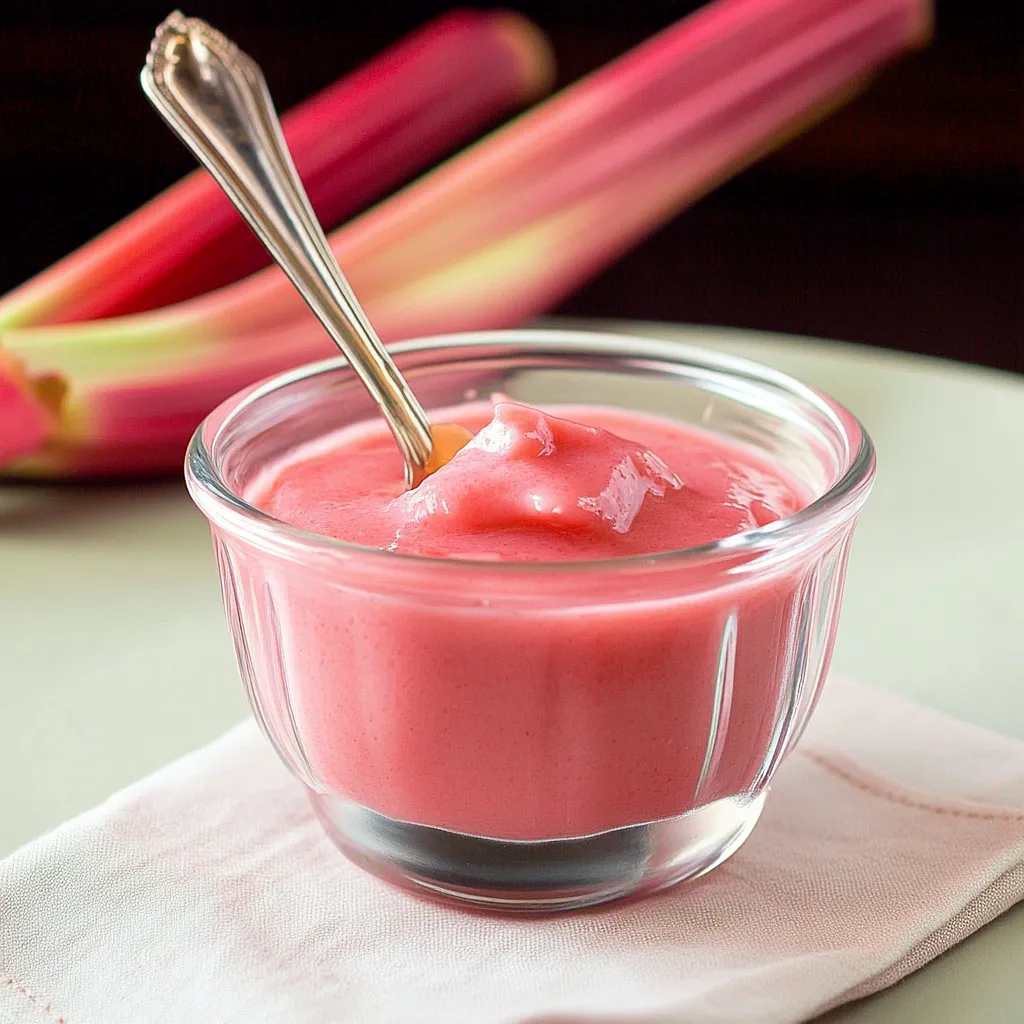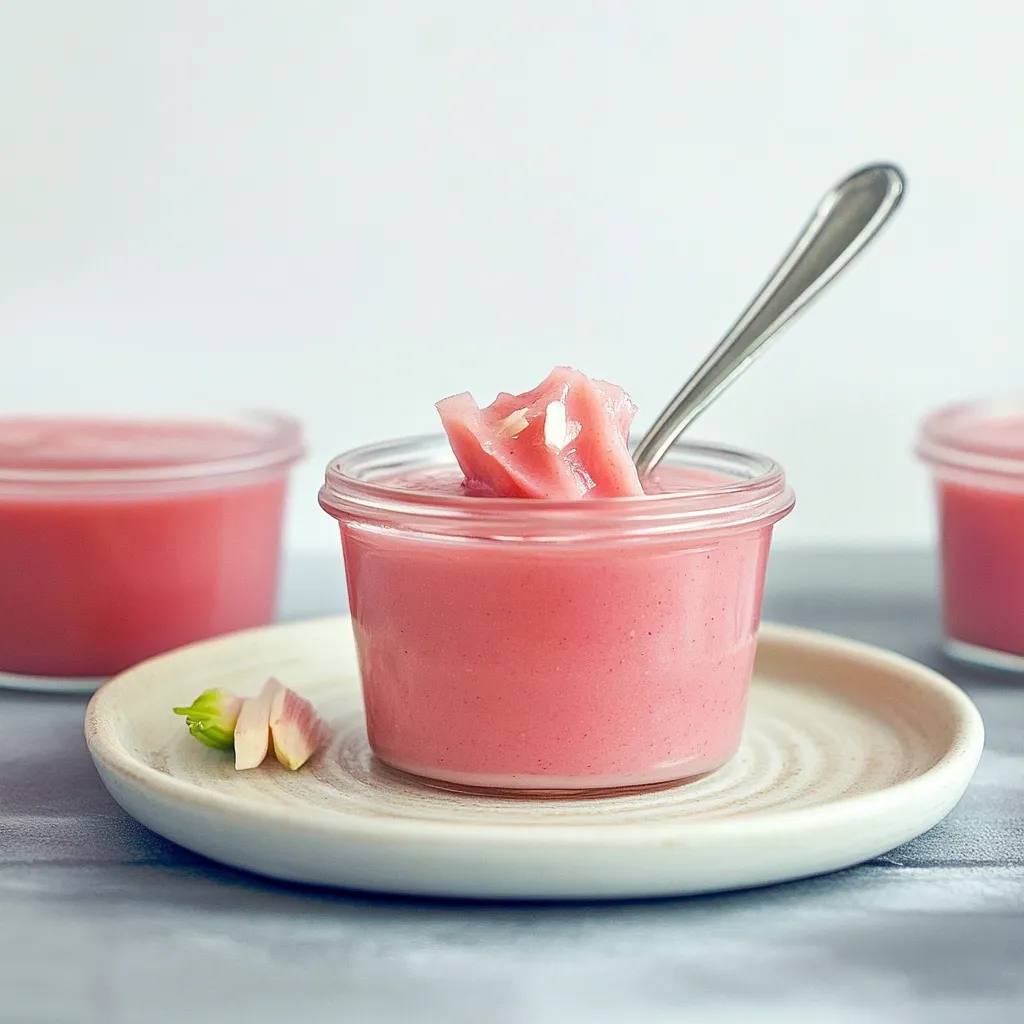 Save
Save
This tangy and vibrant rhubarb curd transforms the distinctive tartness of spring rhubarb into a silky, spreadable delight that bridges the gap between jam and custard. Its pretty pink hue and bright flavor make it perfect for elevating simple desserts or enjoying as a special breakfast treat.
I first made this rhubarb curd when my garden produced an overwhelming abundance of ruby stalks. What began as a creative solution to use my harvest has become a springtime tradition our family eagerly anticipates each year.
Ingredients
- Rhubarb stalks: Provides the signature tart flavor and gorgeous pink color when using red varieties
- Water: Just enough to prevent scorching as the rhubarb begins to release its juices
- Sugar: Balances the natural tartness of rhubarb. Use organic evaporated cane sugar for best results
- Eggs: Creates the custard like texture and helps the curd set properly
- Salt: A small pinch enhances all the flavors and balances sweetness
- Butter: Adds richness and gives the curd its luxurious silky texture
- Vanilla Extract: Rounds out the flavor profile with subtle warmth
Step-by-Step Instructions
- Cook the Rhubarb:
- Place sliced rhubarb in a small saucepan with just a tablespoon of water. This minimal amount prevents initial scorching while the rhubarb breaks down and releases its own liquid. Bring to a boil over medium heat while stirring frequently, then reduce to medium low and cover. Continue cooking for 8 to 10 minutes until the rhubarb completely softens and breaks down into a chunky sauce.
- Puree Until Smooth:
- Transfer the cooked rhubarb to a blender or use an immersion blender directly in the pot. Blend until completely smooth with no remaining fibrous bits. A high powered blender works best for creating the silkiest texture that may not require straining later.
- Combine With Eggs and Sugar:
- Return the pureed rhubarb to a clean saucepan and allow it to cool slightly before adding the sugar, eggs, and salt. Whisk thoroughly until the mixture becomes uniform in color and texture. The cooling step prevents the eggs from curdling on contact.
- Cook Until Thickened:
- Place the saucepan over medium to medium high heat and cook the mixture while stirring constantly. The constant stirring prevents the eggs from scrambling and ensures even cooking. Continue stirring until the curd noticeably thickens and just reaches a boil. The consistency will be similar to a pourable pudding but will thicken further when chilled.
- Finish With Butter and Vanilla:
- Remove from heat and immediately add the butter and vanilla extract. Stir until the butter completely melts and incorporates into the warm curd. The butter enriches the texture while the vanilla balances the tartness with subtle aromatic sweetness.
- Cool and Strain If Needed:
- Allow the curd to cool at room temperature, stirring occasionally to prevent a skin from forming on top. For an extra smooth result, pass the cooled curd through a fine mesh sieve to catch any tiny bits of cooked egg. Transfer to jars and refrigerate for at least 3 to 4 hours until fully set and chilled.
 Save
Save
My favorite part of making this curd is watching the transformation from stringy rhubarb stalks to a glossy pink spread. The first time I served it at our spring garden party, guests kept returning to the dessert table to add more to their scones, completely mystified that something so delicious came from those often overlooked stalks in the garden.
Selecting the Perfect Rhubarb
The color of your finished curd depends entirely on your rhubarb selection. Early season rhubarb tends to be sweeter and more vibrantly colored, while late season stalks become more tart and often more green than red. For the prettiest natural pink color, seek out stalks that are red throughout rather than just on the exterior. Some varieties like Valentine and Canada Red consistently produce the most vivid color. If your rhubarb is more green than red, the curd will still taste delicious but will have a less appealing yellowish green hue.
Natural Coloring Options
If your rhubarb yields a curd that lacks the beautiful pink color shown in the photos, several natural alternatives can enhance the visual appeal. A small amount of dehydrated strawberry or raspberry powder works beautifully without altering the flavor significantly. Dried hibiscus flowers steeped in the cooking liquid then removed before pureeing add both color and a complementary floral note. For the most neutral option, a small piece of fresh beet cooked with the rhubarb then removed before blending will impart a gorgeous pink hue without changing the taste.
Creative Serving Suggestions
This versatile curd extends far beyond the traditional toast or scone topping. Use it as a filling for tarts, macarons, or between cake layers. Swirl it into plain yogurt or oatmeal for a bright breakfast upgrade. For an elegant dessert, layer it with whipped cream and crushed cookies or shortbread for a simple parfait. During summer months, try it as a dip for fresh strawberries or as an unexpected topping for vanilla ice cream. The balance of sweet and tart makes it a perfect partner for buttery pastries or neutral bases that let its unique flavor shine.
Seasonal Variations
The basic technique for this curd can be adapted throughout the growing season as different fruits become available. Early spring forced rhubarb produces the most delicate flavor and color. In summer, try replacing half the rhubarb with strawberries or raspberries for a berry forward variation. Later in the season when rhubarb becomes more assertively tart, increase the sugar slightly or add a touch of honey for balance. The tartness can also be moderated by using sweeter pink or red varieties rather than the more acidic green types.
Frequently Asked Questions About Recipes
- → How do I ensure the rhubarb curd is smooth?
Purée the cooked rhubarb in a blender or use an immersion blender. For extra smoothness, strain the curd through a fine-mesh sieve.
- → Can I adjust the sweetness of the curd?
Yes, adjust the sugar to taste. Rhubarb starts tart, so balance it to your preference without over-sweetening.
- → How do I add natural color to the curd?
Use natural additives like powdered strawberry, raspberry, or hibiscus. Alternatively, cook it with dried hibiscus flowers or a small piece of beet.
- → How long does rhubarb curd last?
Store the curd in an airtight container in the refrigerator. It keeps fresh for up to 2 weeks.
- → What dishes pair well with rhubarb curd?
Rhubarb curd complements pancakes, waffles, scones, ice cream, or even acts as a filling for tarts and cakes.
